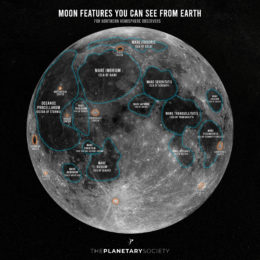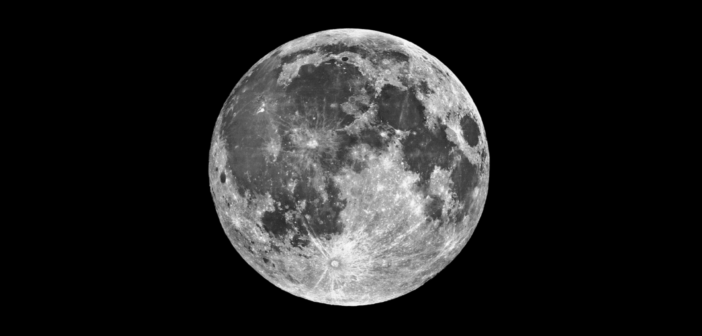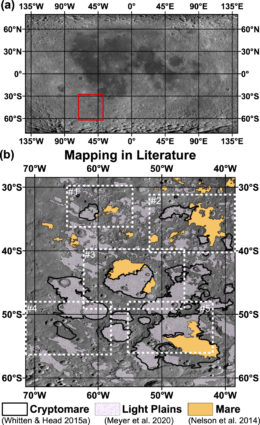Though it is our closest neighbor, the Moon remains partially shrouded in mystery. Under the surface of the Moon lie cryptomaria, remnants of ancient lava flows that were buried during periods of unknown lunar activity. Can radar observations help us map these hidden maria and uncover the secrets of the Moon’s volcanic past?

A map of different features on the Moon. [NASA/GSFC/Arizona State University/The Planetary Society]
It’s a Crater…It’s a Highland…It’s…Hidden Lava Flows?
The Moon is full of interesting geological features, from mountains that form the rims of craters to maria left over from ancient lava flows. However, not all of these features lie on the surface: cryptomaria are maria that formed early in the Moon’s history and have been buried by crater ejecta, hiding them from view. Cryptomaria can be mapped using a number of techniques: photographs reveal their locations on the surface (as they’re usually surrounded by dark-halo craters) and spectroscopic analysis shows their characteristic basaltic composition. A team led by Ali Bramson (Purdue University) has taken a new approach to searching for these buried seas: using radar to map their boundaries.
Looking for Cryptomaria in All the Right Places
Researchers use radar to probe below the surface of the Moon by sending radio waves toward the lunar surface and measuring the waves that bounce back. Observing using this approach can help uncover cryptomaria that are buried too deep to have been noticed in visible images and spectroscopic analyses, and it can also reveal ones that have not been exposed by impact craters.
The team chose the Schiller–Schickard region in order to build on previous volcanic studies, which have used spectroscopy, visible images, and gravity signatures to study the multiple dark-halo craters in the area. Bramson and collaborators study used ground-based radar from the Arecibo and Green Bank telescopes, as well as space-based data from the Lunar Reconnaissance Orbiter Miniature Radio Frequency Instrument (LRO Mini-RF) to observe the region in a new way.
Putting the “Rad” in “Radar”
The team used radar at two different frequencies—P-band (430 MHz) and S-band (2380 MHz)—to study the area. Since the two frequencies probe different depths below the surface and structures of different sizes, any differences in the reflected radar signals would indicate similarities or differences between subsurface structure. Bramson and her team looked at the reflected radar signal in five locations and found new cryptomaria outside of previously mapped areas, indicating that the Schiller–Schickard region contains a large network of ancient lava flows. They also used the radar observations to estimate how deep the cryptomaria are buried and found that, in this region, the ancient lava flows are anywhere from ~10 to ~130 meters below the surface. This also shows that the cryptomaria in the region are more extensive than previously thought. If this is true, it could mean that we’re underestimating the amount of cryptomaria beneath the surface of the Moon by more than a factor of two.
This study only focused on one region where cryptomaria are known to be prevalent, but it shows how useful radar can be in searching for these geologic features. The authors hope that future work will look at other areas where cryptomaria have been hypothesized in order to see if those areas have been underestimated as well.Citation
“Burial Depths of Extensive Shallow Cryptomaria in the Lunar Schiller–Schickard Region,” A. M. Bramson et al 2022 Planet. Sci. J. 3 216. doi: 10.3847/PSJ/ac8670



